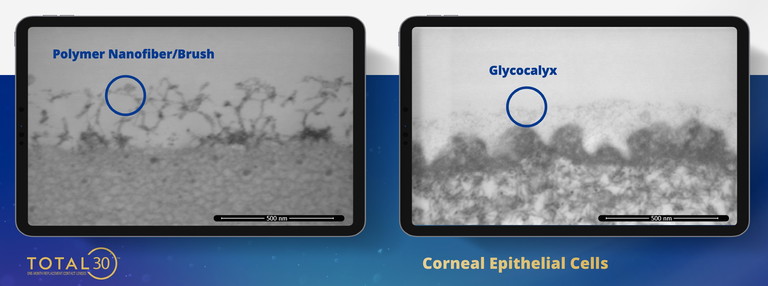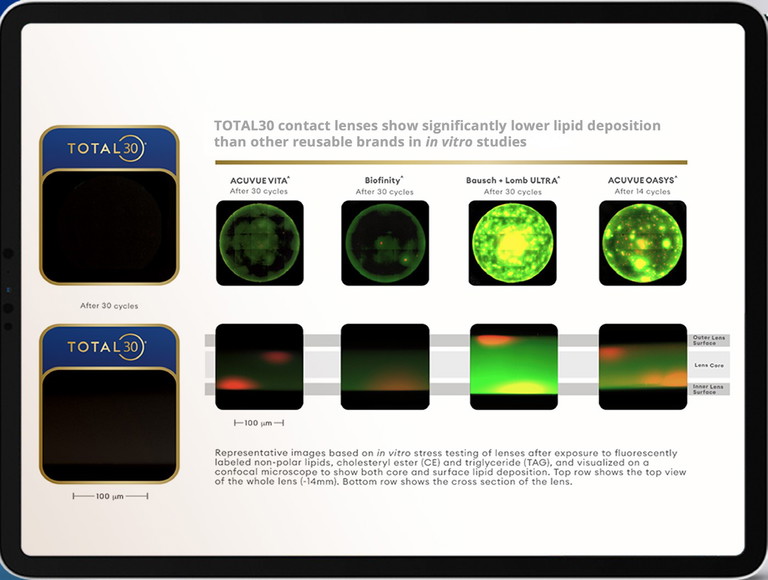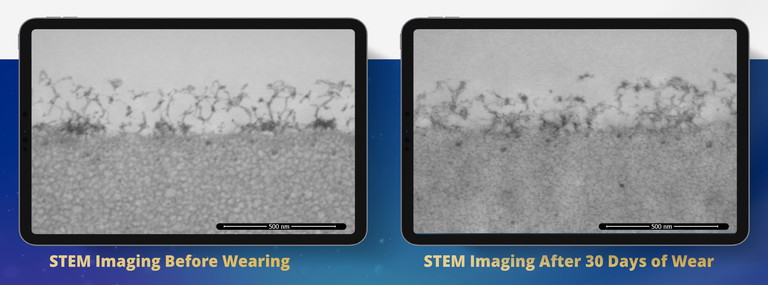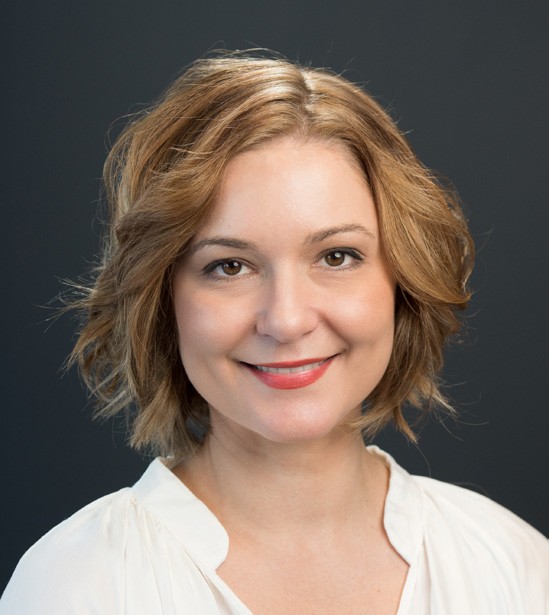mieducation
‘Nothing’ Less Than Brilliant?
Biomimicry in Monthly Contact Lenses
In Australia and New Zealand there is undoubtedly a trend towards fitting daily disposable contact lenses. However, a surprising number of patients have not followed that trend. In Australia and New Zealand, daily disposable lenses have the largest percentage in Australia and New Zealand by value, but when it comes to the number of boxes sold, 58% of patients are still wearing reusable lenses. That number has remained stable over the past five years.1
Recently, Alcon released a new monthly reusable lens, Total30.
WRITERS Helen Gleave, Natalie Rokic, and Matthew Wells
LEARNING OBJECTIVES
On completion of this CPD activity, participants should be able to:
1. Be aware of behaviours guiding reusable vs daily disposable contact lenses,
2. Understand the material properties of Total30 reusable contact lenses, and
3. Realise the benefits of these material properties to wearers.
Two optometrists from Victoria – Natalie Rokic and Matthew Wells – have been trialling Total30, which is inspired by biomimicry of the corneal surface to optimise lens performance for 30 days of wear.
“The percentage of patients wearing reusable lenses in Australia and New Zealand was higher than I would have expected, but I would think it’s often a legacy decision and sometimes a financial choice,” Ms Rokic said.
“When a patient has worn a comfortable monthly contact lens for years and has integrated lens care into their daily rituals, it satisfies their vision needs at a good price. Even though I promote the convenience and hygiene of dailies, as a general rule in my practice, the split is about 50/50 between daily disposable and reusable lenses.”
Mr Wells said most of his new contact lens fits are with daily disposables, “but many of our patients have worn reusable lenses, particularly monthly lenses, for many years”.
“There are a variety of reasons for this, including cost, a reduced parameter range for dailies (especially true in years gone by), concerns around plastic use, and the environmental impact of daily disposables and packaging. Sometimes it may just be habitual,” he said.
Unfortunately for those patients not following the daily disposable trend, there has been a lack of innovation in reusable contact lenses. The last contact lens to launch in the reusable lens category was in 2017.2 Monthly lens wearers have not had the benefit of material upgrades and are more likely to suffer discomfort and dissatisfaction with their lenses. Fifty-eight per cent of all contact lens wearers experience discomfort,3 however this is significantly higher for reusable lens wearers, with 73% of reusable wearers reporting discomfort.4 This discomfort becomes more frequently reported with each progressive week of lens wear through the month. To reduce the level of discomfort, experienced wearers may engage in a range of compensating behaviours5 including using rewetting drops, removing their lenses earlier than they would like, or taking a break from lens wear. It is not surprising to hear over 80% of these patients reported annoyance, frustration, and inconvenience.5
The Alcon research and development team is constantly looking for opportunities to meet unmet needs. Therefore, with this large percentage of patients experiencing discomfort without the option of water surface lenses, the launch of Total30 monthly water gradient contact lenses, which build on the heritage of Total1, is an exciting addition to this category.
Mr Wells said, “We have seen a significant growth in the use of water surface technology daily disposable contact lenses in our practice. Patient comfort is the most significant reason for this change. Our contact lens business continues to grow despite a competitive marketplace and reduced patient dropout due to discomfort is a major factor.
“We have been able to successfully refit existing patients with water surface contact lenses when they have previously been unsuccessful wearers due to discomfort. Our patients also love knowing they are getting the best technology.”
For Ms Rokic, converting patients who have previously dropped out of contact lens wear, and then having them reorder the same Alcon lenses, is a benefit of water surface lenses. “Not all contact lenses provide exceptional all-day comfort, so it’s reassuring when we deliver on a comfortable lens promise.”
While both Total1 and Total30 are water gradient lenses, their material chemistry differs. Made from delefilcon A, Total1 has a core water content of 33%, gradually transitioning to almost 100% water content on the outermost surface.6,7 Total1 exhibits a negative charge on the surface of the lens, which is effective at attracting water molecules to the hydrophilic surface gel, but this charge also attracts positively charged molecules from lens solutions.8

Figure 1.
To design a new monthly lens material that was a true breakthrough in that modality, the ideal properties for a reusable lens were considered. Whereas a daily disposable lens is not required to be compatible with lens solutions, and deposits are less of a concern, solution compatibility and deposit resistance are important to maintain the performance of a reusable lens throughout the month of wear.9

Figure 2.
CREATING A BIOMIMETIC MONTHLY LENS
To create a lens material with these properties, researchers looked to the eye itself for inspiration. Total30 combines the new lehfilcon A water gradient material with Alcon’s Celligent Technology at the surface. The Celligent Technology surface of Total30 contact lenses was inspired by the biology of the ocular surface and is nearly identical to the glycocalyx on the corneal surface (Figure 1).10,15 The structure of the glycocalyx is mimicked by a polymer brush structure of MPC (2-Methacryloyloxyethyl phosphorylcholine) on the lens surface, giving lehfilcon A its biomimetic properties.10
Like the glycocalyx, MPC nanofibres are in a state of constant dynamic movement which, together with the net neutral charge, resists adhesion of bacteria and lipids.11-13, *, ** The constant movement of the nanofibrils sweeps larger molecules away, while allowing the attraction of the smaller water molecules. The surface also exhibits a net neutral charge to enhance compatibility with lens care solutions.14,15

Figure 3.
With deposits a key factor in lens performance across a month of wear, the antifouling properties for lehfilcon A were an important consideration. Bacterial resistance of Total30 and other reusable lenses was compared by immersing the test lenses in a bacterial solution of Pseudomonas aeruginosa. The contact lenses were taken out of the bacteria solution and thoroughly shaken and rinsed to remove loose bacteria. The contact lenses were then processed to remove bacteria that had adhered to the surface of the contact lens. Compared with other reusable lenses, Total30 contact lenses demonstrated 90% less bacterial adhesion in vitro (Figure 2).11,12, *

Figure 4.
Total30 also shows significantly lower lipid deposition after a 30 day cycle in vitro compared with other reusable brands including Biofinity,^ Acuvue Oasys,^ and AcuvueVita.^13,14, ** To represent a wear cycle, the test lenses were put through seven, 14 or 30 cycles of lipid doping in a lipid solution, followed by a rigorous cleaning sequence including rub and rinsing and soaking for six hours in Opti-Free PureMoist. The lipids were fluorescently labeled for confocal imaging. The confocal microscopy images show lehfilcon A has the lowest level of lipid deposition compared with the others across a surface view of the lenses, even after 30 cycles (Figure 3). Furthermore, the lenses were cut to provide a cross section and the level of lipid within the lens core was far lower with lehfilcon A.13,14, **
BIO-INSPIRED SOFTNESS AND LUBRICITY
Other features of corneal epithelial cells are their softness and lubricity, which are also key factors contributing to contact lens comfort. With its bio-inspired contact lens surface, Total30 demonstrates a surface that is highly lubricious16,◊ and a modulus that is as soft as the corneal epithelial cells.17, ◊◊,ǂ
Comfort on lens insertion provides a positive first impression. As part of an early access trial of Total30 in Australia and New Zealand, Mr Wells and Ms Rokic have been fitting Total30 lenses since March 2024.
Ms Rokic said, “Dryness and lack of all-day comfort are the biggest complaints with monthly contact lenses, depending on the age, environment, and occupation of the wearer. Conversion to Total30 has been a positive experience for these people, who often comment, ‘I forget I’ve got them in’.”
Mr Wells said at one month reviews he has been “very impressed at the quality of the lens surface”.
“I have become used to seeing lens surface degradation due to wear and tear and deposits over the month with our previous monthly lenses. In many cases with Total30, the lens looks practically as new. Unsurprisingly, this has led to fantastic patient feedback regarding improved comfort – particularly at the end of the month.”
COMFORT THROUGH TO DAY 30
Discomfort before the end of the wearing cycle is a key symptom of reusable lens wearers. They will often employ one or more compensating behaviours to overcome this. Changing lenses early, taking a break from lenses or using lubricating eye drops are reported, resulting in feelings of annoyance and frustration.5
The surface of Total30 has been designed to withstand 30 days of wear and cleaning. Scanning transmission electron microscope imaging (STEM) shows polymer nanofibre protrusions similar to the glycocalyx (Figure 1).10 STEM images were taken of the surface of unworn lenses and compared to ex vivo images after 30 days of wear and care. The protrusions were shown to be intact when compared to unworn lenses, showing the nanofibre structure is durable to last through 30 days of daily wear, including cleaning, disinfecting, and storing (Figure 4).10,Σ
After her experience with the lenses, Ms Rokic said the benefit of this new technology to patients is “by far the improvement in lens comfort across the month beyond the two-week mark where many people would ‘feel’ the lens”.
“All-day comfort is vastly improved for the entire four weeks with less or no daily dryness symptoms experienced after six to eight hours. Even at the four-week mark with slit-lamp, the lens surface is hydrated with a stable even tear film, adequate lens movement is evident, and both limbus and conjunctivae were white, indicating a well-fitting and hydrated lens.
“Other monthly contact lenses may not look this ‘clean’,” Ms Rokic said.13,α
CATERING TO DIGITAL USE
Total30 lenses have been designed to meet the needs of today’s reusable contact lens wearer. The use of digital devices continues to increase with people spending 13 or more hours per day on digital devices; seven in 10 patients report experiencing digital eye strain.18 Rather than blue light, factors that do contribute to digital eye strain include impacts on the tear film such as blinking less, incomplete blinking, and also uncorrected refractive errors and/or binocular vision anomalies. Uncorrected astigmatism of as little as 0.50 to 1.00D can also increase symptoms of digital eye strain.23
Lehfilcon A is a water gradient material, with a core water content of 55%, changing to almost 100% water at the outermost surface (based on in vitro measurements of unworn lenses).19,20 Water gradient materials are designed to hold moisture over the surface of the lens to support the tear film. To visualise how lehfilcon A maintained moisture over the lens surface in vitro, videos were created using the interfacial dewetting and drainage optical platform (iDDrOP). Lenses were soaked in phosphate buffered saline (PBS) for 16 hours to remove remaining packaging solution then raised above the PBS bath. This in vitro method showed surface wetting properties of different lens materials through the video recordings and lehfilcon A demonstrated a significantly longer surface moisture break-up time than other reusable lenses investigated in the study.21, 22,δ
“ The use of digital devices continues to increase with people spending 13 or more hours per day on digital devices; seven in 10 patients report experiencing digital eye strain ”
Case Study: Natalie Rokic
Patient: Mark Horvath,θ a 23-year-old male works as a welder in an industrial work shed.
Current contact lenses: Air Optix for three years R&L 8.6/14.2/-3.00DS (6/5).
Exam history: Tired, dry eyes from long days at work starting at 5am and finishing at 5pm. Often threw out Air Optix at two weeks due to discomfort. Used Systane frequently. Did not want dailies.
Long working days and overall tiredness exacerbates dry eyes and contact lens comfort and Mr Horvath was unable or reluctant to wear glasses at work due to work tasks (welders’ helmet). Mr Horvath was compliant with wearing safety glasses at all other times.
Mr Horvath’s attendance was timed well with the launch of Total30 spheres and I trialled him in a R and L 8.4/14.2/-3.00 (6/5). The response was immediate with his comment of “feels nice” on his tired eyes at his appointment in the afternoon after work. I reviewed him at four weeks and his response was very positive: he told me that he no longer needed to use Systane during the day. He wore the same contact lens every day for four weeks and was happy he “doesn’t feel them”, describing them as “the best lenses he’s ever worn”.
SPHERE, TORIC, MULTIFOCAL
Total30 provides patients with a full family of water gradient monthly lenses with spheres, torics, and multifocals available from launch. For Alcon, Australia and New Zealand are the first countries in the world to provide this opportunity to fit so many patient prescriptions initially.
Mr Wells said he was “surprised and impressed” when, as part of his early Total30 trial, he had access to sphere, toric, and multifocal lenses “all at the same time”.
“The trial kits are well designed to not take up too much space, but to provide a significant range of lens parameters that I can reach for. This has been helpful as I have proactively refitted many monthly lens wearers on the same day as their routine eye test. This has saved a lot of chair time and patients can walk out with new lenses for a trial immediately.”
So, what is the lens design for the toric? Total30 for Astigmatism incorporates the well proven Precision Balance 8|4 lens design, the same optical design as Total1 and Precision1.
This lens design is a modified prism ballast design with the thickest portions of the lens located at eight o’clock and four o’clock. This has been shown to provide stable vision with five degrees or less of oscillation and settling within three degrees of ideal orientation.24,25 The full parameter range is available from launch: +4.00DS to -8.00DS with four cylinder powers (-0.75DC, -1.25DC, -1.75DC, and -2.25DC), with the core range being available in axes around the clock in 10 degree steps.
“As we know, astigmats can be quite vision sensitive and to be able to offer a hydrated stable lens that maintains good vision throughout the day is a clinical victory,” Ms Rokic said.
“I appreciate the oblique axes and quick stabilisation of Alcon’s toric designs.”
With Total30 Multifocal incorporating Precision Profile lens design, the same optical design across all Alcon multifocals, once familiar with the fitting guidelines, optometrists now have the choice of four lens materials across the two lens modalities.
Ms Rokic said, “In my experience multifocal wearers may report more dryness so I was interested in how end-of-day comfort compared. The overall response was positive and Total30 Multifocals were preferred over the Air Optix Multifocal for comfort.”
To optimise first-fit success for any multifocal contact lens, it is imperative to follow the manufacturer’s fitting guidelines. For the Precision Profile lens design, it is important to take the maximum plus, best vision sphere of the subjective refraction (not the spectacle prescription), back vertex correct this and add an extra +0.25 to the distance prescription before selecting the ADD power. As an experienced Alcon multifocal fitter, Mr Wells offered the following tip: “Like many Alcon multifocal contact lenses, I have needed to boost the plus a little in the Total30 Multifocal lens. Once I have allowed for this, the lens has worked well, and I have had good feedback regarding near performance and comfort – particularly at the end of the month.”
With the launch of Total30 in sphere, toric, and multifocal options, Mr Wells said his monthly contact lens wearing patients were “quite impressed to hear about new technology in the reusable lens space, as it has been a while”.
“ As we know, astigmats can be quite vision sensitive and to be able to offer a hydrated stable lens that maintains good vision throughout the day is a clinical victory ”
Case Study: Matthew Wells
Patient: Priya Singhθ was a happy monthly contact lens wearer, and I proactively recommended Total30 for a trial. She had worn the same brand of reusable toric monthly lenses for 13 years as monovision and had never complained about comfort. Ms Singh was quite happy with her current lenses.
I managed to refit them on the same day using lenses from my Total30 trial kit. Her vision and initial comfort were excellent; each lens was located quickly and was stable.
After one month of wear, the lens surface was exceptionally smooth, and the fit remained excellent. Vision was R: 6/6, L: N5.
After one month, my patient’s feedback was very positive towards the new lens. In particular, she mentioned that she usually could tell towards the end of the month that her lenses weren’t quite as comfortable, but these new ones still felt comfortable. She was very happy to order the new lenses and was appreciative of the opportunity to try the latest technology.
“ To optimise first-fit success for any multifocal contact lens, it is imperative to follow the manufacturer’s fitting guidelines ”
“I explain about how the water surface lenses mimic the corneal epithelium and this leads to greater comfort. I am glad to tell them they can now have the benefits my daily disposable lens wearers have had for some time.”
This article was sponsored by Alcon.
To earn your CPD hours from this article visit mieducation.com/nothing-less-than-brilliantbiomimicry-in-monthly-contact-lenses.
◊ Based on critical coefficient of friction as measured by nanotribometer (‘worn’ lenses were worn for a full wearing schedule: 14 days for Acuvue Oasys. 30 days for all others); p<0.05. ◊◊ Based on surface modulus measured with atomic force microscopy (AFM) nanoindentation (‘worn’ lenses were worn on-eye for a full wearing schedule: 14 days for Acuvue Oasys, 30 days for all others); p<0.05. Ʃ Opti-Free Replenish used for cleaning, disinfecting, and storing, following package insert directions. Based on surface modulus measured with AFM nanoindentation, comparison between lenses with rabbit and human corneas. α In vitro testing of unworn lenses; Compared to Acuvue Vita, Acuvue Oasys, Biofinity, and Ultra^ contact lenses. * Based on in vitro studies on unworn lenses, tested against five strains of P. aeruginosa (MCC 3478, 3480, 3481, 7142, and ATCC 10145) (p<0.0001 for all) and E. coli (p<0.01). ** Based on fluorescent intensity measurements of lipid deposition on the lens surface (p<0.01). ǂ Based on surface modulus measured with AFM nanoindentation; comparison between lenses with rabbit and human corneas. # Based on in vitro testing of out of pack lenses and ex vivo testing of worn lenses; critical coefficient of friction as measured by nano-tribometer; vs Biofinity, Acuvue Oasys, with Hydraclear Plus, Acuvue Vita, and Biofinity. δ Based on an in vitro study on sphere lenses wherein wettability was measured using the iDDrop System (p<0.05). All lenses were tested in an identical manner, soaked in a PBS (phosphate-buffered saline solution) for 16 hours plus/minus two hours (p<0.05). ^ Trademarks are the property of their respective owners. θ Patient names changed for anonymity. ANZ-T30-PRA-2400002

Helen Gleave BScOptom is the Senior Professional Education and Development Manager at Alcon.

Natalie Rokic BOptom PGCertOcTher is an optometrist practising at EyeQ Optometrists in Altona North in Victoria. Since graduating from Queensland University of Technology in 1997, she has worked Australia-wide, but mostly in practices in Queensland and Victoria. Ms Rokic’s professional interests include clinical optometry, contact lenses, children’s vision, and myopia control.

Matthew Wells BOptom PGCertOcTher is a director and optometrist at Hampton Eyecare Optometrists in Victoria. His special interests include contact lenses and paediatric care. He has taught at the University of Melbourne and at Deakin University over his 25-year career.
References
1. CLI Marketshare data, Q3 2023. Alcon Data on File: REF-23786.
2. Bausch and Lomb, History and Heritage (webpage). Available at: bausch.com/about-bausch-lomb/historyheritage [accessed April 2024].05/04/2024.
3. Nichols JJ, Willcox MOP, Sullivan DA, et al. The TFOS international workshop on contact lens discomfort: Executive summary, Invest Ophthalmol. Vis. Sic. 2013;54 (11): TFOS57-TFOS13. doi: 10.1167/iovs.13-13212.
4. Schnider C, Evaluating monthly replacement contact lens patient satisfaction. Abstract and lecture presented at: American Academy of Optometry Conference; 2016; Orlando, Florida.
5. Schnider C, Wales M, Monthly contact lens wearers can thrive, not just survive, Optometry Times. Available at: optometrytimes.com/view/monthly-contact-lens-wearerscan-thrive-not-just-survive [accessed April 2024].
6. Thekveli S, Qui Y, Pruitt J, et al. Structure property relationship of delefilcon A lenses, Cont Lens Ant Eye 2012; 35. e14. doi: 10.1016/j.clae.2012.08.044 (sponsored by Alcon).
7. Angelini T, Nixon R, Sawyer W, et al. Viscoelasticity and mesh size at the surface of hydrogels characterized with microrheology. Invest Ophthalmol Vis Sci. 2013;54:500.
8. Schafer J, Steffen R. Evaluation of surface water characteristics of novel daily disposable contact lenses using refractive index shifts after wear. Invest. Ophthalmol. Vis. Sci. 2013;54(15):487.
9. Papas E, Ishihara K, Hong Y, et al. A biomimetic approach for development of a next-generation monthly contact lens, Water Gradient Technology: Evolution Through Biomimicry, available at: digital.clspectrum.com/articles/a-biomimeticapproach-for-development-of-a-next-generation-monthlycontact-lens [accessed April 2024] (sponsored by Alcon).
10. Alcon, Scanning transmission electron microscopy of lehfilcon A contact lens and human corneal surface; Alcon data on file, 2020. [Doc. No V-RIM-0032716, p1–3].
11. Alcon, In vitro evaluation of bacterial adherence in commercial lenses; Alcon data on file, 2020 [Doc. No TDOC-0057567, p4].
12. Alcon, In vitro evaluation of bacterial biofilm in commercial lenses; Alcon data on file, 2020 [Doc. No. V-RIM-0027277, p1].
13. Alcon, In vitro evaluation of lipid deposition for lehfilcon A sphere and commercial sphere lenses using 3D confocal imaging; Alcon data on file, 2021 [Doc. No. V-RIM-0034922, p4].
14. Ishihara K, Fukuzawa K, Wu JY, et al. Antifouling silicone hydrogel contact lenses with a bioinspired 2-methacryloyloxyethyl phosphorylcholine polymer surface. ACS Omega. 2021;6:(10):7058-7067. doi: 10.1021/ acsomega.0c06327.
15. Shi X, Cantu-Crouch D, Ishihara K, et al. Surface characterization of a silicone hydrogel contact lens having bioinspired 2-methyacryloyloxethyl phosphorylcholine polymer layer in hydrated state. Colloids Surf B: Biointerfaces. 2021;199:111539. doi: 10.1016/j. colsurfb.2020.111539.
16. Alcon, Surface lubricity testing of lehfilcon A and commercial lenses using nano-tribometer; Alcon data on file, 2020. Doc. No. V-RIM-0031794, p2].
17. Alcon, Laboratory analysis of surface modulus of lehfilcon A and commercial lenses using atomic force microscope; Alcon data on file, 2020. Doc. No. V-RIM-0032036, p3].
18. American Optometric Association. Computer vision syndrome. 2017. Available at: aoa.org/healthy-eyes/eyeand-vision-conditions/computer-vision-syndrome?sso=y [accessed May 2024].
19. Alcon, In vitro analysis of lehfilcon A contact lenses outermost surface softness and correlation with water content; Alcon data on file, 2021 [Doc No. A02491REP-197506, p4].
20. Alcon, In vitro analysis of lens oxygen permeability, water content, and surface imaging; Alcon data on file, 2021 [Doc No. A02491-REP-198231-1, p4].
21. Alcon, Surface Analysis of worn and out of pack lehfilcon a lenses; Alcon data on file, [Doc. No. A02491REP-182069-1 p8].
22. Based on in vitro studies of unworn Total30 and competitive sphere lenses (Biofinity, Ultra, Acuvue Oasys, and Acuvue Vita) using average iDDrop water break-up time (WBUT); Alcon data on file, 2021 [REF-12543, p1].
23. Wolffsohn JS, Lingham G, Craig JP, et al. TFOS Lifestyle: Impact of the digital environment on the ocular surface. Ocul Surf. 2023 Apr;28:213–352. doi: 10.1016/j. jtos.2023.04.004.
24. Alcon, In a clinical trial to evaluate stability of axis orientation of Total1 for Astigmatism lenses where n=47; Alcon data on file, 2020 [Ref 09861].
25. Based on lens movement, centration, and rotation at initial fitting. Alcon, In a clinical trial to evaluate on-eye performance of Total30 for Astigmatism lenses where n=69; Alcon data on file, 2021 [Ref 12050].